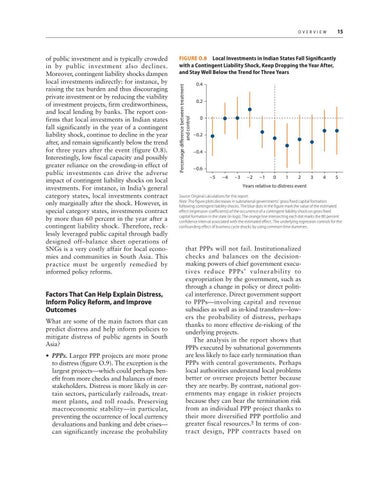OVERVIEW 15
Factors That Can Help Explain Distress, Inform Policy Reform, and Improve Outcomes What are some of the main factors that can predict distress and help inform policies to mitigate distress of public agents in South Asia? • PPPs. Larger PPP projects are more prone to distress (figure O.9). The exception is the largest projects—which could perhaps benefit from more checks and balances of more stakeholders. Distress is more likely in certain sectors, particularly railroads, treatment plants, and toll roads. Preserving macroeconomic stability—in particular, preventing the occurrence of local currency devaluations and banking and debt c rises— can significantly increase the probability
FIGURE O.8 Local Investments in Indian States Fall Significantly with a Contingent Liability Shock, Keep Dropping the Year After, and Stay Well Below the Trend for Three Years Percentage difference between treatment and control
of public investment and is typically crowded in by public investment also declines. Moreover, contingent liability shocks dampen local investments indirectly: for instance, by raising the tax burden and thus discouraging private investment or by reducing the viability of investment projects, firm creditworthiness, and local lending by banks. The report confirms that local investments in Indian states fall significantly in the year of a contingent liability shock, continue to decline in the year after, and remain significantly below the trend for three years after the event (figure O.8). Interestingly, low fiscal capacity and possibly greater reliance on the c rowding-in effect of public investments can drive the adverse impact of contingent liability shocks on local investments. For instance, in India’s g eneral category states, local investments contract only marginally after the shock. However, in special category states, investments contract by more than 60 percent in the year after a contingent liability shock. Therefore, recklessly leveraged public capital through badly designed off–balance sheet operations of SNGs is a very costly affair for local economies and communities in South Asia. This practice must be urgently remedied by informed policy reforms.
0.4 0.2 0 −0.2 −0.4 −0.6 −5
−4
−3
−2
−1
0
1
2
3
4
5
Years relative to distress event Source: Original calculations for this report. Note: The figure plots decreases in subnational governments’ gross fixed capital formation following contingent liability shocks. The blue dots in the figure mark the value of the estimated effect (regression coefficients) of the occurrence of a contingent liability shock on gross fixed capital formation in the state (in logs). The orange line intersecting each dot marks the 80 percent confidence interval associated with the estimated effect. The underlying regression controls for the confounding effect of business cycle shocks by using common time dummies.
that PPPs will not fail. Institutionalized checks and balances on the decisionmaking powers of chief government executives reduce PPPs’ vulnerability to expropriation by the government, such as through a change in policy or direct political interference. Direct government support to PPPs—involving capital and revenue subsidies as well as in-kind transfers—lowers the probability of distress, perhaps thanks to more effective de-risking of the underlying projects. The analysis in the report shows that PPPs executed by subnational governments are less likely to face early termination than PPPs with central governments. Perhaps local authorities understand local problems better or oversee projects better because they are nearby. By contrast, national governments may engage in riskier projects because they can bear the termination risk from an individual PPP project thanks to their more diversified PPP portfolio and greater fiscal resources.9 In terms of contract design, PPP contracts based on

